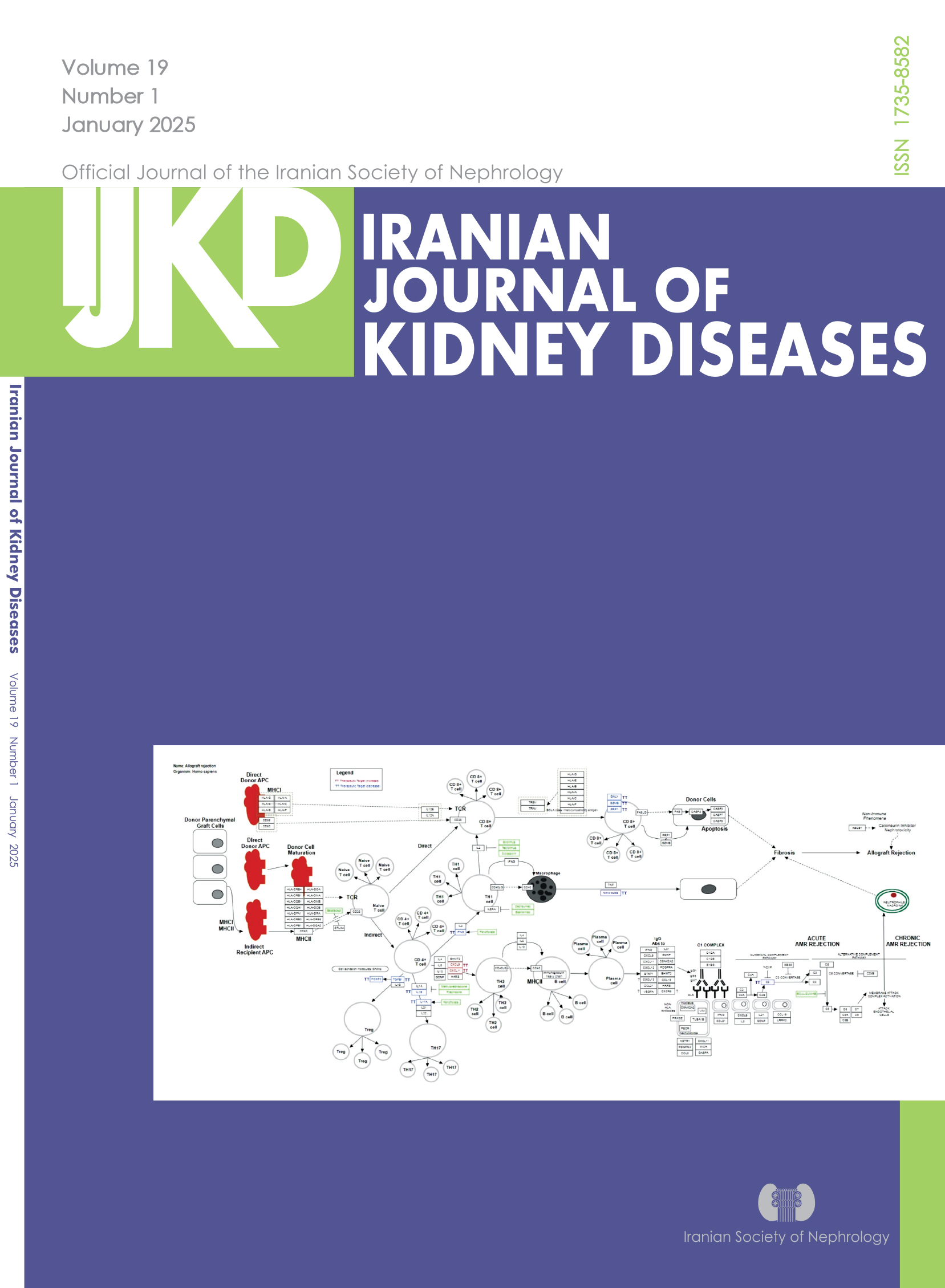Effect of the Combination of Hemodialysis and Hemoperfusion on Clearing Interleukin-31: A Prospective, Randomized Crossover Trial in Patients under Maintenance Hemodialysis
DOI:
https://doi.org/10.61882/ijkd.19.1.1Keywords:
Hemodialysis, Interleukin-31, Pruritus, HemoperfusionAbstract
Introduction. Uremic pruritus (UP) is a disturbing symptom in a quite large proportion of hemodialysis (HD) patients. Recent studies have indicated a potential role of interleukin-31 (IL-31) in the pathophysiology of pruritus, and it is becoming a promising therapeutic target for UP. Hemoperfusion (HP) is an extracorporeal technique that has been shown to be effective in absorbing molecules which may be responsible for inducing pruritus. In this study, we conducted this study to explore whether additional HP could enhance the removal of IL-31 in UP patients.
Methods. The study was conducted in two parts. In Part A, the prevalence and intensity of UP were recorded and the basal serum IL-31 level was determined three times a week in HD patients. Patients with detectable serum IL-31 levels in part A were included in Part B. Each patient had two 4-h test sessions: conventional HD or HD plus HP (HDHP). The reduction ratio (RR) of IL-31 from HD and HDHP was compared.
Results. Forty patients completed part A and 40% of them were suffering from UP. Serum IL-31 was detected at significantly higher percentages in UP patients than in non-UP patients (50% vs 4.2%). Serum levels of IL-31 in UP patients were significantly higher than that in non-UP patients (median: 8.35pg/ml vs 7.8pg/ml). Serum IL-31 levels were significantly correlated with pruritus intensity in patients with UP(r = 0.55, P < .05). Eight patients were enrolled and completed part B. The use of combined HD and HP treatment produced a better RR for IL-31 than HD alone (34.26 ± 1.43% vs 15.28 ± 2.11%, P < .01).
Conclusions. IL-31 may play an important role in the pathophysiology of uremic pruritus. The addition of hemoperfusion to conventional hemodialysis provides enhanced removal of IL-31.
Downloads
References
1. Curtin RB, Bultman DC, Thomas-Hawkins C, Walters BA, Schatell D. Hemodialysis patients’ symptom experiences: effects on physical and mental functioning. Nephrol Nurs J. 2022; 29(6): 562, 567-574.
2. Pisoni RL, Wikström B, Elder SJ, et al. Pruritus in haemodialysis patients: international results from the Dialysis Outcomes and Practice Patterns Study (DOPPS). Nephrol Dial Transplant. 2006; 21(12):3495-3505.
3. Kuypers DRJ. Skin problems in chronic kidney disease. Nat Clin Pract Nephro. 2009; 5(3):157-170.
4. Arai I, Tsuji M, Miyagawa K, Takeda H, Akiyama N, Saito S. Repeated administration of IL-31 upregulates IL-31 receptor A (IL-31RA) in dorsal root ganglia and causes severe itch-associated scratching behaviour in mice. Exp Dermatol. 2015;24(1):75-8.
5. Tseng PY, Hoon MA. Oncostatin M can sensitize sensory neurons in inflammatory pruritus. Sci Transl Med. 2021;13(619): eabe3037.
6. Dillon SR, Sprecher C, Hammond A, et al. Interleukin 31, a cytokine produced by activated T cells, induces dermatitis in mice. Nat Immunol. 2004;5(7):752-60.
7. Gonzales AJ, Humphrey WR, Messamore JE, et al. Interleukin-31: its role in canine pruritus and naturally occurring canine atopic dermatitis. Vet Dermatol. 2013;24(1):48-53.
8. Oyama S, Kitamura H, Kuramochi T, et al. Cynomolgus monkey model of interleukin-31-induced scratching depicts blockade of human interleukin-31 receptor A by a humanized monoclonal antibody. Exp Dermatol. 2018; 27(1):14-21.
9. Hawro T, Saluja R, Weller K, Altrichter S, Metz M, Maurer M. Interleukin-31 does not induce immediate itch in atopic dermatitis patients and healthy controls after skin challenge. Allergy. 2014;69(1):113-7.
10. Oweis AO, Al-Qarqaz F, Bodoor K, et al. Elevated interleukin 31 serum levels in hemodialysis patients are associated with uremic pruritus. Cytokine. 2020; 138:155369.
11. Ko MJ, Peng YS, Chen HY, et al. Interleukin-31 is associated with uremic pruritus in patients receiving hemodialysis. J Am Acad Dermatol. 2014; 71(6):1151-9
12. Kinugasa E, Igawa K, Shimada H, et al. Anti-pruritic effect of nemolizumab in hemodialysis patients with uremic pruritus: a phase II, randomized, double-
blind, placebo-controlled clinical study. Clin Exp Nephrol.2021;25(8):875-884.
13. Heike M Hermanns. Oncostatin M and interleukin-31: Cytokines, receptors, signal transduction and physiology. Cytokine Growth Factor Rev. 2015;26(5):545-58.
14. Ankawi G, Fan W, Pomarè Montin D, et al. A New Series of Sorbent Devices for Multiple Clinical Purposes: Current Evidence and Future Directions. Blood Purif. 2019;47(1-3),94-100.
15. Mistik S, Utas S, Ferahbas A, et al. An epidemiology study of patients with uremic pruritus. J Eur Acad Dermatol Venereol. 2006; 20(6):672-678.
16. Furue M, Ebata T, Ikoma A, et al. Verbalizing Extremes of the Visual Analogue Scale for Pruritus: A Consensus Statement. Acta Derm Venereol. 2013;93(2):214-215.
17. Bergstrom J, Wehle B. No change in corrected beta
2- microglobulin concentration after cuprophane haemodialysis. Lancet. 1987;(8533):628-629.
18. Rymsza A, Świerczyńska K, Piotrowska A, Dzięgiel P, Szepietowski JC. The Serum Level of IL-31 in Patients with Chronic Kidney Disease-Associated Pruritus: What Can We Expect? Toxins (Basel). 2022;14(3): 197.
19. Li WH, Yin YM, Chen H, et al. Curative effect of
neutral macroporous resin hemoperfusion on treating hemodialysis patients with refractory uremic pruritus. Medicine (Baltimore). 2017 ;96(12): e6160.


